Thursday, 30 April 2020
Fox News Breaking News Alert
Trump says he's seen evidence suggesting coronavirus emerged from Wuhan lab, compares WHO to PR agency
04/30/20 3:59 PM
Fox News Breaking News Alert
Dozens of protesters, some armed, enter Michigan Capitol as tensions over coronavirus restrictions escalate
04/30/20 2:38 PM
Fox News Breaking News Alert
Strzok had stopped FBI from ending Flynn probe despite lack of 'derogatory' evidence, documents show
04/30/20 12:36 PM
New story in Technology from Time: Apple Is Making it Way Easier to Unlock Your iPhone While Wearing a Mask
If you’ve been having trouble unlocking your pesky iPhone while wearing a mask, you’re not alone.
As many of us are wearing facial coverings while out of the house to curb the spread of COVID-19, it’s proving difficult to use the Face ID unlocking feature in newer iPhones, like the iPhone 11. Luckily, an upcoming software update from Apple is making it easier to deal with the frustration, though not in the way you might think.
Among various bug fixes and improvements, Apple’s upcoming iOS 13.5 update includes a minor but important change to the iPhone lock screen. When you pick up a Face ID-capable iPhone, it usually prompts you to show your mug to the front-facing camera to get inside your device. Failing that, the iPhone asks you to enter your passcode — but it can take a few seconds before the passcode option appears.
With the upcoming update, iPhone users will be able to swipe up from the bottom of the lock screen to instantly jump to to the passcode option, manually and quickly bypassing Face ID. The update is currently in beta before being rolled out more widely.
Of course, using this option may mean your rarely-used passcode or uncomfortably long password will see a lot more use, which can eat up even more time. To make your passcode easier to enter (helpful when hauling groceries home) you can visit the Settings app, select Face ID & Passcode, and enter a new, shorter password. Just remember to keep it hard to guess — shorter passcodes can be easier to remember, but can also be less safe. You may also see the option to “Set Up an Alternate Appearance.” Before you get your hopes up, thinking you can just configure your iPhone to recognize you with your mask on, it unfortunately won’t work with a mask obstructing half your face.
While Apple’s Beta Program is open to everyone who wants to join, doing so isn’t recommended if your device is “mission-critical,” so to speak. Beta versions of software often contain bugs that may leave users vulnerable to glitches that could result in lost data, or exploits that have yet to be patched in that particular version. So it’s better to wait for this feature to come to the general public, which shouldn’t take long.
Fox News Breaking News Alert
Intel boss confirms investigation into coronavirus, ‘accident’ at Wuhan lab
04/30/20 8:25 AM
Fox News Breaking News Alert
EXCLUSIVE: Biden has long-standing, close ties to University of Delaware trustees controlling the Senate papers his critics want
04/30/20 3:04 AM
Wednesday, 29 April 2020
Fox News Breaking News Alert
Newsom to close all California beaches in crackdown: report
04/29/20 9:32 PM
Fox News Breaking News Alert
FBI considered interviewing Michael Flynn 'to get him to lie' and 'get him fired,' handwritten notes show
04/29/20 4:12 PM
Fox News Breaking News Alert
WATCH LIVE: Trump meets with CEOs of major businesses on jump-starting America's economy
04/29/20 1:20 PM
Fox News Breaking News Alert
GOP senators have new warning about jobless benefit change
04/29/20 10:24 AM
Fox News Breaking News Alert
Watch: America Copes Together: A Virtual Town Hall with Harris Faulkner at 1 pm ET on Fox News Channel
04/29/20 9:59 AM
Fox News Breaking News Alert
NYT: Biden camp's talking points 'inaccurately' describe Reade reporting
04/29/20 9:43 AM
Fox News Breaking News Alert
THAT WAS THEN: What Biden's possible running mates said about Kavanaugh case and what they are saying about Tara Reade's claims
04/29/20 7:00 AM
Fox News Breaking News Alert
Irrfan Khan, actor in ‘Slumdog Millionaire,’ dead at 53
04/29/20 1:40 AM
Tuesday, 28 April 2020
Fox News Breaking News Alert
EXCLUSIVE: Tara Reade criticizes Hillary Clinton after Biden endorsement
04/28/20 1:25 PM
Fox News Breaking News Alert
Biden accuser Tara Reade calls for release of his Senate records
04/28/20 11:51 AM
Fox News Breaking News Alert
US coronavirus cases surpass 1 million
04/28/20 11:22 AM
Fox News Breaking News Alert
Clinton teases she'll be at Biden town hall, endorsement expected
04/28/20 11:17 AM
Monday, 27 April 2020
Fox News Breaking News Alert
Biden silent on Tara Reade sexual assault allegation, as denials come from campaign
04/27/20 3:42 PM
Fox News Breaking News Alert
WATCH LIVE: Trump holds White House news conference on response to coronavirus outbreak
04/27/20 2:40 PM
Fox News Breaking News Alert
Neighbor, colleague reportedly back Biden accuser Tara Reade's claims
04/27/20 12:51 PM
Fox News Breaking News Alert
New York cancels Democratic presidential primary set for June 23 amid coronavirus pandemic
04/27/20 9:44 AM
New story in Technology from Time: Scammers Could Be After Your Stimulus Check. Here’s How to Avoid Them
For scammers, confusion and desperation can make even the most careful people vulnerable to their schemes. And when it comes to the government’s stimulus payments, both are in ample supply.
As part of an effort to keep the economy afloat during the COVID-19 pandemic, the Internal Revenue Service (IRS) is sending payments of up to $1,200 or more to millions of Americans. But confusion around when and how those payments will arrive, in combination with people’s desperation for financial relief, have made the process a playground for scammers of all kinds. The Federal Trade Commission (FTC) has received more than 18,000 complaints of fraudulent activity related to stimulus payments, the agency said on April 15.
Some scammers may be after the payments themselves, while others are using the opportunity to get valuable personal information, like bank account numbers, from unsuspecting targets.
Keeping yourself from getting scammed out of your stimulus payment or personal information is a pretty straightforward affair. Here’s what to look out for.
Beware stimulus-related emails, calls, and texts
That the government would call you up to let you know your stimulus payment is on the way or to ask for some personal information before dropping your check in the mail sounds pretty convenient.
But the IRS is far too busy even to answer questions about the stimulus payments. It simply doesn’t have the resources to be calling or texting anyone right now. So if someone emails, calls or texts you for your personal information — maybe they’re claiming they can facilitate a faster payment, or need more information to send your money — it’s likely someone trying to scam you.
“The IRS doesn’t initiate contact with taxpayers by email, text messages or social media channels to request personal or financial information,” reads the agency’s page related to phishing and other scams. “This includes requests for PIN numbers, passwords or similar access information for credit cards, banks or other financial accounts.”
You can visit the IRS’ Get My Payment page to check the status of your payment and more.
Check the language
The stimulus payments aren’t actually called “stimulus checks,” despite the popularity of the term. According to the IRS, its official term is “economic impact payment.” So if you get an email, call or text using the unofficial language of “stimulus check,” it’s a tip-off that the message isn’t legit.
Watch for your receipt
Whether you receive your stimulus payment via direct deposit or as a paper check through snail mail, the IRS will also send you a letter in the mail 15 days later letting you know that the payment was sent. The agency won’t be hounding you or anyone else over the phone, email or text about it.
That letter is useful because it serves as official verification that your stimulus payment was sent out. If you get one after receiving your payment, then you’ve got nothing to worry about. But if you get one before your payment arrives, it’s a sign that something may be amiss.
“This is another way people can be alerted to a potential scam,” says Kimberly Palmer, a personal finance expert at NerdWallet. “If you get the letter stating the IRS did send your payment, but you actually didn’t get the payment — maybe it’s not in your bank account, or you didn’t get the paper check, then that’s … a huge red flag.”
Receiving the letter before your payment could be a signal that the IRS sent the check to the wrong mailing address or bank account, so be sure to double-check the information the agency has on file for you.
Don’t like what you see? Tell the FTC
If you get a suspicious call, email, or text about your stimulus payment, first of all, don’t open it. Secondly, it’s a good idea to let the FTC know about it, so it can track and warn others of scams. The agency has a complaint page where you can easily report suspicious activity to help others from getting duped.
Sunday, 26 April 2020
Fox News Breaking News Alert
PROGRAMMING ALERT: Pete Hegseth hosts 'America Together' special, 10 pm ET on Fox News
04/26/20 6:54 PM
Fox News Breaking News Alert
Treasury Secretary Steven Mnuchin tells ‘Fox News Sunday’ when he thinks economy will bounce back
04/26/20 7:42 AM
Fox News Breaking News Alert
Watch Sunday Mass from St. Patrick’s Cathedral in NYC live at 10:15 a.m. ET on FoxNews.com
04/26/20 7:14 AM
Saturday, 25 April 2020
Fox News Breaking News Alert
EXCLUSIVE: Biden accuser blasts CNN's Cooper, others over 'blatant bias'
04/25/20 8:40 PM
Fox News Breaking News Alert
Liberal CNN FINALLY covers Larry King clip after development in Biden sexual assault claim
04/25/20 1:14 PM
Fox News Breaking News Alert
Global coronavirus death toll passes 200,000
04/25/20 12:33 PM
Friday, 24 April 2020
Fox News Breaking News Alert
Footage from a decades-old TV interview offers new clue about a former Joe Biden aide's claim the then-senator sexually assaulte
04/24/20 5:48 PM
Fox News Breaking News Alert
President Trump and the White House coronavirus task force are holding their daily briefing. Watch now on Fox News Channel and F
04/24/20 2:41 PM
Fox News Breaking News Alert
Disgraced lawyer Michael Avenatti released from New York jail
04/24/20 12:08 PM
New story in Technology from Time: Facebook Is Taking On Zoom With a 50-Person Video Chat Feature
(Bloomberg) — Facebook is launching a new group video chat product meant to capitalize on a world now stuck indoors and offer an alternative to services that have exploded in popularity in recent months, like Zoom.
Messenger Rooms, a feature that will be available on Facebook’s core social network and its Messenger app, will allow video chats among as many as 50 people, and won’t require participants to have a Facebook account, the company said Friday in a blog post. Chats will be free with no time limit, and eventually users will be able to create a “room” from any of Facebook’s products, including WhatsApp and Instagram.
The goal is a group video product that feels more social, and less corporate than what’s currently available, said Facebook Chief Executive Officer Mark Zuckerberg. People in Messenger Rooms will be able to use Facebook’s augmented reality filters, or jump between chats to visit different groups of friends, an effort to create “spontaneity and serendipity,” Zuckerberg added.
“All the products [out] there were primarily focused on enterprises and we thought that there was an ability to do something in the consumer space,” the Facebook CEO said this week via video chat from his home. “It’s meant to be more casual. Not everything has to be planned out in advance.”
Video chats have become a staple given the billions of people around the world staying indoors because of the coronavirus pandemic. Zoom Video Communications Inc.’s app, aimed at companies for business meetings before the outbreak, has jumped from about 10 million users to more than 300 million in a matter of months. Zoom’s shares declined 2% after Facebook’s announcement, reversing a gain of as much as 7.3% earlier Friday.
Houseparty, owned by Epic Games Inc., which also lets users bounce between group chats, said it added 50 million new sign-ups in a 30-day stretch, as much as 70 times its normal amount in some markets.
Facebook, too, has a number of video chat products already in high demand. More than 700 million people make voice or video calls every day on Messenger or WhatsApp, Zuckerberg said, a number that has increased since the emergence of Covid-19.
The Menlo Park, California-based company started shifting product priorities last month after seeing those spikes in usage from people using its live video and calling features. The demand prompted Facebook to announce other video features this week, including the ability to save Instagram Live videos after they’re over, and start a video chat inside Facebook’s dating feature. Video chats on WhatsApp can now host eight people, twice the previous amount.
While Zoom has surged, it has struggled with a series of security mishaps that put users’ privacy at risk. It also suffered from “Zoombombing,” where internet trolls took over chats and posted pornography or racist content to unsuspecting participants.
Zuckerberg said he has learned from Zoom’s early mistakes. Facebook users who create a chat can also select participants, eject people if needed or lock the room. The company won’t watch or listen to calls, and there is no ability for users to record video chats, a spokesperson said.
The social network’s algorithms will help determine which available rooms to show users, Zuckerberg said, recognizing that not all Facebook friends are created equal.
“We all have the random uncle or someone that you added a few years ago,” he said. “Not every one of your Facebook friends is someone you want to hang out with.”
Zuckerberg said Facebook’s long-term priorities haven’t changed much. The company still is moving forward with plans to encrypt all its messaging services, and make them interoperable — meaning you’ll eventually be able to send a message from WhatsApp to a user on Instagram, for example.
The Rooms video chat feature, he said, “is probably one of the first very clear consumer services that has integration and works across each of the apps. That’s an important piece – maybe an initial milestone on the path to broader interoperability.”
Fox News Breaking News Alert
Trump signs nearly $500 billion emergency interim coronavirus relief package
04/24/20 9:39 AM
New story in Technology from Time: Volunteers Are Collecting Tablets for COVID-19 Patients So They Don’t Have to Suffer Alone
One text message made Sara Rodell realize how lucky she was to hold a smartphone in her hands.
It arrived in late March, from a friend trying to collect tablets for New York City nurses. She heard that nurses were trying to facilitate video calls for their patients, most of whom were not allowed to accept visitors due to restrictions meant to stop the spread of COVID-19. Patients without their phone or charger, or who simply didn’t own one, were often unable to see their families in some of the hardest — or last — days of their lives.
“Not having that moment of closure is something that is going to be really haunting for us as a society to move through,” Rodell says. “I think it will be a big part of our collective grieving.”
Rodell saw a way to ease the burden. The CEO of Loop & Tie, a platform that helps companies send gifts to their clients, Rodell realized she could use her company’s infrastructure to ship tablets to hospitals to assist with video calls between patients and their loved ones. She and a team of almost a dozen other women, many who have never met face-to-face, joined together as COVID Tech Connect to make it happen.
They began asking companies to donate tablets, and started a GoFundMe to raise money for shipping and extra device purchases. As of late April, they’ve gotten commitments for about 4,500 device donations, raised more than $180,000, and started making shipments to hospitals, focusing first on those in New York City and other particularly hard-hit areas.
Keep up to date with our daily coronavirus newsletter by clicking here.
Other groups are also working to foster connections for those suffering alone. Connect 4 COVID, started by brothers Sunny Sandhu and Manraj Singh, is trying to bring families connection and closure by sourcing lightly-used device donations from individuals, as well as larger donations from organizations. As of late April, they’ve collected more than 250 smart devices and are in talks with a number of large companies interested in donating more.
They got their idea after Sandhu, a senior at Princeton University, self-isolated due to possible COVID-19 exposure. Though physically alone, Sandhu was pleasantly surprised by how connected video chatting made him feel to friends and family around the world. But he quickly realized he “was fortunate enough to have a smart device in my hands [and] many others weren’t.”
After that experience, Sandhu and Singh, a consultant with Deloitte, started asking friends who worked in the medical field if they could use donated smart devices to help patients connect with their families. They got an overwhelming response, and forged partnerships with medical students in cities including Baltimore, New York, Miami, Boston and Washington, D.C.
“Not having a smartphone isn’t a human rights issue,” Singh says. “But dying alone, without your loved ones in your corner, that is.”
Yentli Soto Albrecht, Singh’s college lab partner and a University of Pennsylvania medical student involved with the Philadelphia Organization of Health Professional Students (POHPS), immediately understood the brothers’ vision. Albrecht had just finished an internal medicine rotation at a Philadelphia hospital, and she’d watched its visitor policy go from relaxed to draconian. She got POHPS on board, and is helping coordinate device distribution in Philadelphia.
Fellow POHPS member Stephanie Fagbemi, a medical student at nearby Temple University, also saw the need for tech in hospitals — but for a different reason. In November, her uncle had traveled to the Philippines for an extended vacation. He only had a flip phone, so Fagbemi couldn’t reach him often. She and her family didn’t know until it was too late that he’d been hospitalized for diabetes-related complications. He died before he could make it home to the U.S.
“It’s been really hard for us to actually feel like he’s gone,” Fagbemi says. “That part of the grieving process has been pretty difficult — also the idea that we weren’t able to say goodbye, and we can’t have a funeral.”
Fagbemi is helping POHPS distribute smart devices to Temple hospitals and Philadelphia nursing homes, in hopes of sparing other families from the pain hers has gone through. “It would have been really meaningful for my family just to be able to see my uncle and say ‘I love you’ one last time,” she says.
On the West Coast, medical students at the University of California, San Francisco have come together under the name Connecting During COVID to offer a unique medical consult service. If a doctor or nurse at one of four San Francisco hospitals treats a patient who is isolated from his or her family, the care team can call the group’s student volunteers, who will coordinate a video call for the patient using one of 25 donated tablets. The students are not allowed to visit rooms with COVID-19 patients, but they’ve seen plenty of demand among patients who are hospitalized for other conditions but unable to welcome visitors due to temporary hospital policy.
In some cases, UCSF student Sophie McAllister says, the conversation is more for a seriously ill person’s family than it is for the patient; sometimes the patient isn’t even conscious, but their loved ones want to say goodbye face-to-face anyway. “They just want to have that moment and play music and have these feelings and moments together,” she says. “I’ve cried in patients’ rooms before. It’s really tough being there for this moment you wouldn’t normally have been a part of.”
But, she adds, the pain is a small price to pay for giving patients the connection they deserve. “We’re spending a lot of time [doing things] that brought me to medicine” in the first place, she says.
Please send any tips, leads, and stories to virus@time.com.
Fox News Breaking News Alert
US coronavirus death toll passes 50,000
04/24/20 7:52 AM
Fox News Breaking News Alert
Media erupt over Trump comments on disinfectant and sunlight to cure coronavirus: Here's what he said
04/24/20 6:54 AM
Thursday, 23 April 2020
Fox News Breaking News Alert
Cincinnati Bengals select Heisman Trophy winner Joe Burrow as first pick in NFL Draft
04/23/20 5:28 PM
Fox News Breaking News Alert
House passes $484B coronavirus small business relief bill, sends to Trump
04/23/20 3:18 PM
Fox News Breaking News Alert
WATCH LIVE: President Trump, coronavirus task force hold daily briefing
04/23/20 2:50 PM
New story in Technology from Time: Working Out at Home? Here’s the Smartest Exercise Gear You Can Use
Stuck indoors thanks to the COVID-19 outbreak? That doesn’t mean you necessarily have to embrace your inner sloth. Instead, it’s a good idea to find ways to stay active, especially for the physical and mental health benefits of exercise.
For home workout equipment that can really make sure each session counts, you’re going to want some smarter gear, preferably something that keeps track of how much work you’re putting in. Here’s some of our favorite high-tech home workout gear that can track every run, rep or whatever else you’re up to:
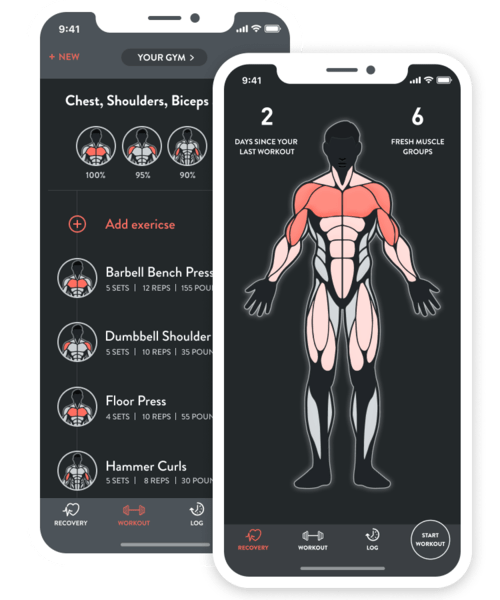
Fitbod
Price: $3.99 per month
What is it: A smart workout tracking and training app
If you’ve got no equipment to work with at home, or are new to the whole home workout thing, check out Fitbod for an easy introduction to body weight and other at-home exercises. Fitbod can build your workout routine — including weight, sets, and reps — for you based on the muscles you want to target, along with the equipment you have (or don’t have). The visual chart showing your muscle groups after each workout make it easy to see when you’re overtraining, or what you’re neglecting in your routine. It even includes instructional videos you can watch before you pull a muscle, just in case you need a refresher on how to do a proper push-up.
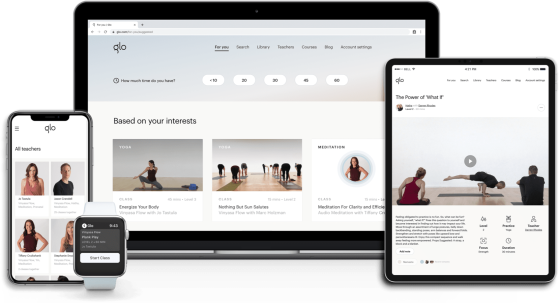
Glo Yoga
Price: $18 per month
What is it: An on-demand yoga and meditation class subscription
Just because you’re getting in shape doesn’t mean you’ve got to carry huge weights around your house, or spend a ton on equipment. Sometimes you just need a yoga mat and a smartphone. With Glo, a subscription-based yoga and meditation service that works on iOS, Android, and TV platforms like Roku, Amazon’s Fire TV, and Apple TV, you have access to over 4,000 classes ranging from mindfulness meditation training to multiple styles of yoga.
You can also choose classes based on what you’re trying to accomplish, whether it’s nailing the basics of yoga, staying focused, or strengthening your body with more workout-focused exercises. Videos are grouped into courses so you can follow one over multiple weeks, making it easy to stick to a particular style or follow a certain teacher.

Crossrope
Price: $99
What is it: A jump rope with interchangeable weighted ropes
Jump ropes are a great way to get the heart thumping, but those light nylon ropes aren’t exactly going to help with your biceps. The Crossrope’s four interchangeable ropes — ranging from a quarter-pound to two pounds — are designed for intense and lengthy workouts, and easy to switch up thanks to the handle’s clever connectors. Available in multiple lengths, it might be the thing that helps you build up more than a just a sweat. Just make sure the neighbors below you don’t mind.
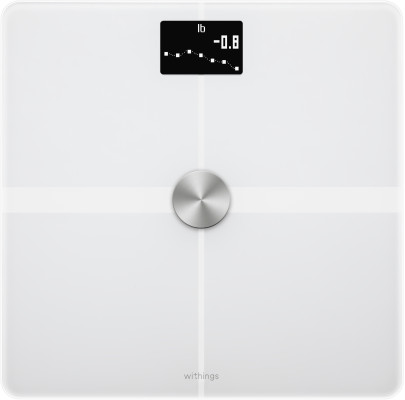
Withings Smart Scale
Price: $99
What is it: A WiFi-connected weight and body mass scale
The Withings Smart Scale is great for simple tracking of both your short-term and long-term fitness progress. Syncing with your Apple Health or Google Fit information, the Withings Healthmate app makes it simple to see your weight, body mass, or heart rate trends in an easy to read and date-adjustable graph, along with the rest of your health data. It also displays data like weather forecasts and carbon dioxide levels in your room, just in case you need to know the weather before you hit the gym or go for a run.
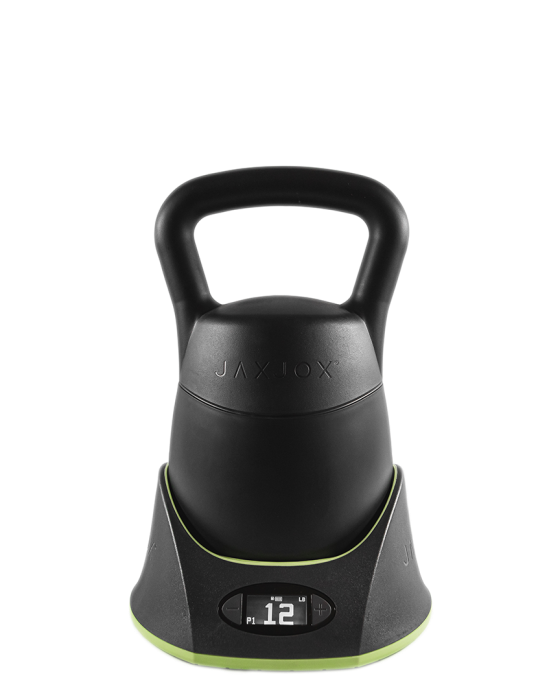
JAXJOX Kettlebell
Price: $229
What is it: A weight-adjustable smart kettlebell
If kettlebells are more your speed, you can always get one that lets you know how hard you’re working out. The JaxJox KettlebellConnect can replace your entire set, thanks to its adjustable weight capabilities. Ranging from 12 to 42 pounds, the KettlebellConnect is great for beginners and experts alike looking to collect some data from their workout routine. The companion app tracks everything from sets, reps, and time spent working out, creating a proprietary Fitness IQ score designed to show how fast you’re progressing. It all syncs with your Apple Health or Google Fit data, too.

Bowflex SelectTech 560
Price: $549
What is it: A set of smartphone-friendly, weight-adjustable dumbbells
Just because they’re called dumbbells doesn’t mean they have to be, well, dumb. If you want exercise equipment just as advanced as the rest of your workout gear, try the Bowflex SelectTech 560, a set of smart adjustable dumbbells complete with companion app (and winner of a Red Dot design award).
Adjusting the weights is simple enough, requiring a handle twist before removing them from their dock. The Bowflex SelectTech app records your weight settings, along with set and rep counts. It also provides dozens of videos to choose from when you want to customize your workout regimen, target a specific muscle group, and nail your technique.

Wahoo Kickr Smart Trainer
Price: $1,199
What is it: A smartphone-friendly bicycling trainer
Instead of taking your bike for a ride outside when you should be staying in, why not rack up a few miles with a bike stand?Available in both wheel-on and wheel-off variants, the Kickr series of trainers is controlled by your smartphone — you can use Kickr’s app to manage elements of your ride (like resistance), view your power output, and combine your Kickr with other Wahoo-made cycling components, like an elevation accessory to simulate uphill rides. The Kickr also syncs with apps like Strava to log your rides.

Fightcamp
Price: $1,219
What is it: A punch-tracking boxing system with on-demand workouts
No, you can’t be in the ring throwing your fists at some sweaty competitor right now, but you can beat on your own punching bag from the comfort of your home. Fightcamp’s boxing workouts are quantified thanks to its in-glove sensors that track your fists of fury while you punch away (purchasing a Fightcamp set nets you gloves, sensors, and a punching bag). You’ll get stats based on everything from your jab speed to intensity to types of punches thrown while you hone your skills. Fightcamp puts its guided workouts in its subscription service, which gets you over 200 workouts to choose from.
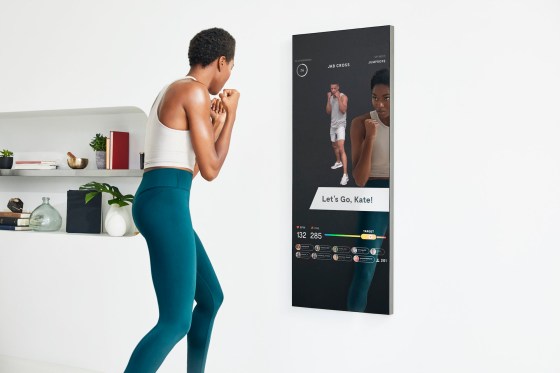
Mirror
Price: $1,495
What is it: A workout-specific wall-mounted display that doubles as a mirror
If you miss your group classes at your now-shuttered local gym, Mirror might be a great choice, letting you break a sweat without taking up too much space in your apartment. Despite the name, Mirror does more than reflect your image back to you. It’s an internet-connected mirror that integrates a huge display for streaming workout classes, and a camera for personal training sessions. A subscription to Mirror’s workout catalog grants you access to classes ranging from strength training to yoga to everything in between, available at all experience levels. While the company has since postponed its live classes, you can still access its over 10,000 pre-recorded on-demand workouts to get your gains in.

Ergatta
Price: $1,999
What is it: A gamified rowing machine
Rowing machines aren’t new, but rowing machines pitting you against your fellow athlete are pretty novel. Enter Ergatta, a gorgeous, traditional-looking rowing machine that won’t look out of place in your home — as long as you ignore the 17-inch touchscreen attached to the wooden water flywheel rower.
Unlike other smart rowers, the Ergatta puts less emphasis on on-demand workout videos and more on your training regimen, turning your sessions into races against others. You’ll get a stylish interface that lets you choose workout plans, pick competitive races, and puts you and your rowing activity on a leaderboard — especially helpful since you’re not exactly rowing on the water with your buddies. When you’re done, you can fold the Ergatta up for convenient vertical storage, so no one trips over your new workout machine of choice.
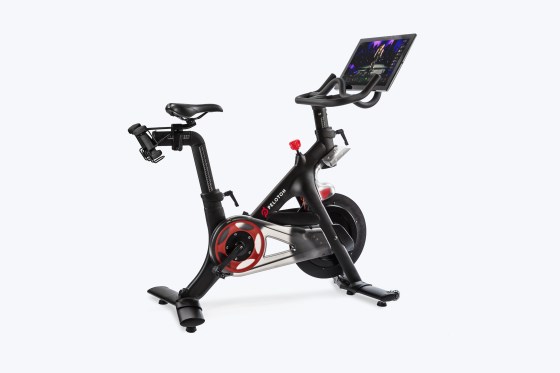
Peloton Stationary Bike
Price: $2,245
What is it: An internet-connected stationary bike with a touchscreen and on-demand workout catalog
If you want a smart stationary bike that makes you feel like you’re in a spin class even though you’re stuck in your basement, check out Peloton. The king of connected stationary bikes, Peloton’s futuristic-looking spin bike has an integrated touchscreen display that makes finding a workout for your skill level or monitoring your progress incredibly simple. Classes are shown on the integrated display, which displays data like speed, distance, cadence, and more so you know how hard you’re working. You’ll also find a leaderboard where you can compare your performance to your fellow riders in your class (you can also hide it if that’s not your thing).
Peloton’s live classes are currently on hiatus, but the company has tons of pre-recorded classes available, with a few more on the way.
New story in Technology from Time: I’m Gaming My Way Through Quarantine — and That’s Nothing to Feel Guilty About
I’m a big reader. I love fiction and non-fiction, I love paper books, audiobooks, e-books, comic books, whatever. And I live near a world-class library for easy access to all of the above. But since the COVID-19 pandemic changed everyone’s lives, I’m struggling to get lost in their worlds. While reading, my mind invariably wanders to the outbreak.
What I can do is play video games. Lots of video games. Something about gaming has been more engaging than reading, giving me that escape I so badly need right now. Over the past few weeks, the Final Fantasy VII Remake, Call of Duty: Warzone, Red Dead Redemption 2, and Fallout 76 have consumed the hours I used to set aside for reading and other activities, like spending time with friends in person.
I am not alone — gaming is up 75% on Verizon’s networks, the company says — and, despite calls to use this time for more “productive” pursuits, I am not ashamed. Sure, I could be mastering bread-making, catching up on my reading backlog, writing a novel, or doing the myriad household tasks I need to tackle. But I’m not. I’m gaming. It’s fun, it kills time, and, crucially, it’s a way to make “social distancing” feel a little more social and a little less distant.
I’m lucky. I’m not sick and no one in my family is sick. I’m still working and have the luxury of playing games to pass the time. And experts say behavior like mine won’t hurt, and may even help, so long as I’m taking care of myself in other ways.
“Accumulating evidence suggests that playing video games isn’t really associated with negative outcomes,” says Chris Ferguson, an associate professor and department chair of psychology at Stetson University. He notes that it’s still important for adults and children alike to exercise and get their work and chores done. But, he says, “as long as that’s all checked off, there are honestly no maximum limits on video game time, particularly as right now there might not be much else to do.”
That’s good news not just for me, but also for the many others out there gaming their way through the outbreak. Take, for example, Donovan Beeson, a 37-year-old in Chicago who’s been furloughed from her job as an executive assistant. She’s supposed to go back to work on May 18, but she thinks COVID-19 will keep her at home much longer. “I’m definitely gaming more,” she says. She’s been filling her time with Animal Crossing: New Horizons and Animal Crossing: Pocket Camp on her phone. These games, in which players do various errands to spruce up their environments, offer a satisfying “virtual to-do list,” she says.
“They tick that ‘you’ve done a thing’ box in my brain when I can’t be doing lots of things,” says Beeson. They also give her a way to connect with her nieces, two young Animal Crossing fans who live miles away in Florida. “They set up an Easter egg hunt for me with the bunny-day themed stuff,” she says. “I was impressed and touched. They made me wear one of the egg day outfits when I came over to [their island to] do it.”
Ellen Blackman, an English instructor at the University of South Carolina, is breaking up her days of recording video lectures and logging on to Zoom meetings with Stardew Valley, in which players run a farm in a small town. “I had this gut reaction of, ‘oh, that sounds comforting,'” says Blackman, 38. “So I loaded that up and started a new game.”
Blackman says she likes open-ended, uncomplicated games. “I don’t like to play platformers or anything with a lot of combat because I get frustrated and I have other parts of my life that are frustrating, so I don’t know why I would want my leisure activities to be frustrating,” she says. She’s also played a little of the space exploration simulator No Man’s Sky and has eyed Animal Crossing, but doesn’t own a Switch, the only console for which it’s available. “They require just enough concentration that you can clear your brain of the things that are causing some anxiety, and stress, and worry,” she says. “But they themselves are not replacing that anxiety with ‘oh, I’m not good at the game.’”
For others, gaming is a way to stay connected to friends who they can’t see in person right now. Garrick Gomez, a 36-year-old support engineer at a Dallas-based financial software firm, has long used games to stay in touch with friends. “I think everyone having to isolate … has really forced everyone to reach out and try to play games and find games that we can all jump on,” he says.
Gomez says he’s even made new connections since self-isolation started. “I’ve definitely played with people I don’t know, that are just friends of buddies,” he says. “Everyone is locked down and playing games so the online gaming community is thriving, and even expanding, which is kind of neat.”
Ferguson says that gaming with friends is a good way to fill the void in our social lives left by the lockdowns. “Most humans just aren’t built for this,” he says. “Video games can be an excellent platform for getting social needs met. That was true pre-COVID, and that’s even more true when other avenues are largely cut-off.”
In the early days of social distancing, calls to use our suddenly ample time to be productive were plentiful. But it’s not an easy time to stay focused on work, school, or anything else. Many of us stuck at home simply need something to keep our minds off the unspeakable horrors unfolding across our cities, our country and the world. Video games, with their robust stories, hours of playtime and built-in social connections, can be that something. They have been for me, and many others — and we shouldn’t feel guilty about any of it.
Wednesday, 22 April 2020
Fox News Breaking News Alert
Tornadoes rip through Texas, Oklahoma: reports
04/22/20 9:13 PM
Fox News Breaking News Alert
WATCH LIVE: Trump gives updates on coronavirus with White House task force
04/22/20 3:13 PM
Fox News Breaking News Alert
Harvard won't 'seek or accept' federal stimulus money after calls from Trump to return cash
04/22/20 12:56 PM
Fox News Breaking News Alert
Pelosi sidelines plan for proxy voting amid coronavirus
04/22/20 9:33 AM
New story in Technology from Time: Don’t Feel Bad if Your Kids Are Gaming More Than Ever. In Fact, Why Not Join Them?
I’ve been thinking an awful lot about the 1989 Detroit Pistons over the past few days. Rick Mahorn, the starting power forward, can’t make a goddamn layup. Neither can Dennis Rodman. Isaiah Thomas is missing too many shots. Do I have anyone on my team who can stop Michael Jordan, who over the past four games is averaging 83.5 points per game against a squad once known as “The Bad Boys” because of its nasty defensive disposition? I’m not seeing much Bad in these Boys.
Yeah, it would probably be sorry enough if I was consumed by the actual Detroit team that last played an actual NBA game at the outset of the George H.W. Bush administration. But no, I’m talking about the video game version of that championship squad. In NBA 2K20, the popular virtual hoops game that for many fans has replaced real basketball during the coronavirus pandemic, you can play using one of many fine historic NBA squads. And currently, my 13-year-old son and I are in a heated best-of-seven series, featuring my ‘89 Pistons versus his 1991 Chicago Bulls, another NBA title team, on our PlayStation 4. He’s up three games to one.
For a middle-aged man with many adult responsibilities, stressing about Bill Laimbeer’s minutes during these scary times doesn’t seem very healthy.
But what if it actually is? Over the past month or so, while quarantined at home, my son and I have turned to video games as a welcome distraction. With New York City officials having removed all public park basketball rims across the Big Apple in order to enforce social distancing, digital hoops serves as our substitute for the real thing. I find myself looking forward to our daily (or more) 2K battles to break up the monotony. We talk some trash. We share a few laughs. I enjoy educating him about the great NBA teams of my youth. He pretends to care. Then we go back to an uncertain reality.
We’re not alone. Sequestered people around the globe are playing more video games during the pandemic. Gaming was up 75% in the first week of mass self-isolation alone, Verizon says. The supply of Nintendo Switch consoles, a popular choice for families, kids and casual gamers, can’t keep up with demand. Animal Crossing: New Horizons, the latest version of the long-running Nintendo franchise, in which people can hang out online together on digital deserted islands, has sold more than 3 million copies in Japan since its March 20th release. Sales of video game hardware, software, accessories and game cards in the U.S. exceeded $1.6 billion in March, according to the NPD Group, the highest March level since 2008. Hardware spending spiked 63% compared with March 2019, while software grew 34%. While there’s no Major League Baseball right now, NPD Group says MLB The Show 20 had the highest-selling debut month in the popular baseball franchise’s history.
Keep up to date with our daily coronavirus newsletter by clicking here.
Rather than rue this pandemic-driven video game and screen time boom, research suggests we should be cheering it. Playing in moderation, naturally, is key; in May of 2019, the World Health Organization officially voted to include “gaming disorder,” or video game addiction, in its International Classification of Diseases. But research shows that video games can provide important social, motivational, emotional, and cognitive benefits. “And if video games had been beneficial before now,” says Linda Kaye, senior lecturer in psychology at Edge Hill University in the U.K., “then now, they’re as important as ever.”
Experts say we need to shed the stereotypical image of gamers as isolated loners playing for hours on end in a dank basement. Today, kids and adults can socialize with one another, in groups large and small, while playing games online. During the pandemic, connectivity stands out. “It’s all about the social interaction,” says Isabela Granic, professor of developmental psychopathology at Radboud University, in the Netherlands. “You build your own gardens with other people. You play in teams overcoming other teams and militias and whatever it is. And it’s really checking a lot of those social needs in this time of isolation. And as much as kids need us, they need each other just as much.” (I’m starting to feel like my son would be better off playing 2K with his pals instead of me.)
Instead of feeling guilty about kids’ video game screen time, Granic — who leads the Games for Emotional and Mental Health Lab at Radboud — suggests that “parents should feel like they’re offering an opportunity they wouldn’t have had 30 years ago.” Granic’s gaming rule for her twin 14-year-old boys: unlimited video game time before an 8 p.m. dinner, but first they have to do their homework, practice playing a musical instrument, do some coding, read part of a novel, and go outside for an hour. That works out to about 90 minutes of video games a night.
Gaming has benefits for people of all ages. According to a 2016 study conducted by Columbia University’s Mailman School of Public Health, high video game usage among children aged 6-11 was associated with high intellectual functioning and competence in school and fewer relationship problems with peers. In a survey of 900 people in 45 countries who play online multiplayer role-playing games, Mark Griffiths, professor of psychology at Nottingham Trent University and one of the world’s foremost video game researchers, found that approximately three-quarters of both male and female respondents reported making good friends while playing games (the average number of “good friends” was seven). What’s more, 10% of the study participants developed at least one romantic relationship with someone they had met in the game. One of his subjects in a later case study even ended up marrying someone he met playing World of Warcraft.
During a video interview with TIME, Griffiths’ son, 18, was in another room playing games. Grffiths very much approved. “In times of spatial distancing, gaming is what he’s playing with his best mates,” he says. “The last thing I want is my children to be tearing their hair out. Gaming is one of the enjoyable, engrossing things kids like to do.”
Gaming can help players develop a range of skills, experts say. “People learn how to negotiate, collaborate, to take turns, to think critically with others, and so on,” says Granic. “Motivationally, people learn how to persevere in the face of failure. To take failure over and over and still work at some kind of goal. Game designers, for a long time, have been these sorts of wizards of engagement. And they figured out how to keep us at that sweet spot of learning. They’re still better at it than most teachers are.”
There’s evidence that video games can help with mental health, too. “When you’re battling yourself with traumatic thoughts, you can lose yourself in a game,” says Michelle Colder Carras, a public health researcher at Johns Hopkins University who played World of Warcraft to alleviate her own past bouts with depression. She’s published a study illustrating the therapeutic benefits of video games for military veterans. “Right now, during this pandemic, real life is the traumatic situation,” says Colder Caras. “What games are able to do for people in mental health recovery, all of society now needs.”
Granic agrees. “Kids are as anxious as parents right now with this epidemic,” she says. “There’s lots of them worried about their health, about their parents’ health. The formula for anxiety is unpredictability, having no control, and a potential threat out there where you have no agency yourself to do anything about. And what are games really, really good at? Giving you control, giving you predictability, and having potential threats overcome by things you can do, things you have agency over.”
Research shows that video games can be good for your brain in other ways, too. German researchers, for example, have found that adults who played Super Mario 64 for 30 minutes a day for two months had increased grey matter — where the cell bodies of the brain’s nerve cells are situated — in the right hippocampus, right prefrontal cortex and the cerebellum, regions involved in functions like spatial navigation, memory formation, strategic planning and fine motor skills.
It’s important for parents to make sure their kids are finding ways to get physical exercise in this moment, too. Workout oriented games like Nintendo’s Ring Fit Adventure can help, but there’s no digital substitute for real fresh air. While doing a video interview with TIME, Craig Stark, professor at the University of California, Irvine’s Center for the Neurobiology of Learning and Memory, said that his eighth grade son was on a headset chatting with his friends while gaming. “I’m great with that,” says Stark. Still, he adds, “if you’re gaming 20 hours a day, let’s get out, let’s do some other stuff, let’s not just talk to each other on a screen. But in terms of the notion that video games are actively rotting the brain? No, I don’t see any evidence for that.”
See you later, boss. Those ‘89 Pistons are about to mount a comeback. My son — and our PS4 — await.
Please send any tips, leads, and stories to virus@time.com.